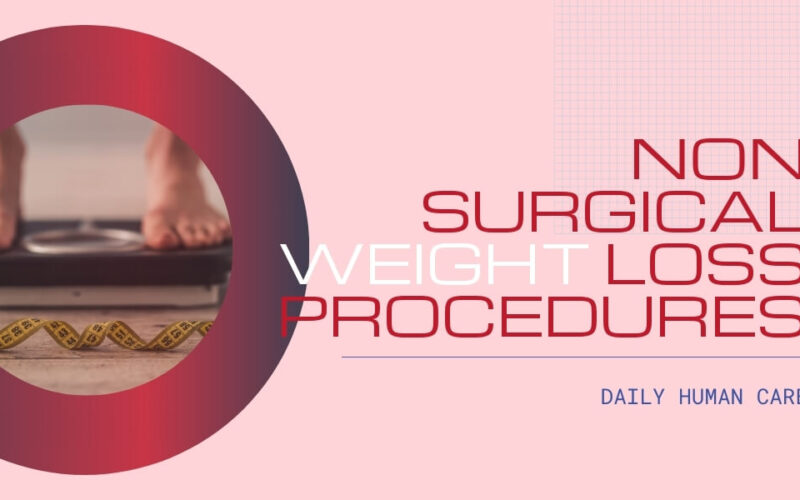Table of Contents
Non-surgical weight loss procedures
In this article, we will discuss Non- surgical weight loss procedures.
The best non-surgical weight loss procedures may include,
- An endoscopic sleeve gastroplasty
- Endoscopic gastric outlet repair
- Gastric balloon
- Aspiration therapy
NON-SURGICAL WEIGHT LOSS TREATMENTS
The Non-surgical procedures for weight loss include,
- Gastric balloon:
A balloon, inflated with saline, takes up space in the stomach, creating a feeling of satiety (fullness).
- Aspiration therapy:
This weight loss system involves a stomach tube that attaches through a port to a companion device for removing part of the meal.
- Endoscopic sleeve gastroplasty:
Physicians use an endoscope (thin, flexible tube with a lighted camera) to place sutures from inside the stomach to create a smaller, tube-shaped stomach pouch
- Endoscopic gastric outlet repair:
This procedure also involves sutures, placed from inside the stomach, to reduce the size of the stomach pouch and stoma (opening from pouch to the small intestine).

1. Endoscopic Sleeve Gastroplasty
HOW IT WORKS
This is one of the best non-surgical weight loss procedures. Gastroplasty of the endoscopic sleeve decreases the stomach size without surgery. The doctor uses a thin, flexible tube (endoscopic device) with a small camera to build a little tube-like stomach. This reversible non-surgical procedure restricts both the food an individual may consume and the calories that can be consumed.
PROCEDURE FOR
A few steps are required in the outpatient procedure for endoscopic sleeve gastroplasty:
- Endoscopy: The doctor inserts an endoscope with the attached suture device into the stomach through your mouth while you are under general anesthesia.
- Suture placement: The doctor puts in your stomach about 12 sutures. The sutures decrease your stomach by 80% to make a pouch in the form of a tube.
- Optional removal: Most people may not need an endoscopic gastroplasty sleeve reversed. The sutures can be removed in an outpatient, endoscopic procedure if necessary.
LIFESTYLE CHANGES FOR HEALTHY WEIGHT MAINTENANCE
Post-procedure diet recommendations include:
- Clear first day liquids
- Two weeks of full liquids
- Three to four weeks of purified food
- Five to six weeks of soft food
- Daily foods, as you feel relaxed with the calory prescription of your dietitian
To keep your weight stable for a lifetime, it is essential to change lifestyles. We suggest
- Eat nutritious foods in smaller portion
- Daily physical exercise
- Active involvement in the intensive lifestyle counseling program including counseling with a conduct consultant
2. Intragastric balloon
Endoscopic balloon therapy gives a wide variety of patients who wish to lose weight an excellent chance.
INTRAGASTRIC BALLOON for weight loss
The intragastric ball provides a temporary solution for weight loss non-surgical. The ball takes room in the stomach and allows people to feel faster and eat less.
PROCEDURE
Here’s how the intragastric balloon non-surgical weight loss procedures plan works:
- Insertion: The physician places the ball into your stomach with a small lighted camera using a thin, flexible tube (endoscope). The endoscope moves through your mouth and traces your esophagus to your stomach. The operation is under light anesthesia (conscious sedation).
- Inflation: The ball is inflated by filling a sterile saline solution to take space into your stomach during the same ambulatory operation, which makes you consume less food and feels fuller.
- Balloon weight loss: The ball stays in your belly for six months, as you engage in monthly appointments, including dietary support for weight loss and lifestyle improvement coaching.
- Removal: After six months, the doctor deflates the balloon and removes the device from the mouth using an endoscopic technique. For the removal process, you will obtain anesthesia.
- Continued support: Every six months, you begin your monthly appointments in our lifestyle coaching program, for a total of 12 months.
3. Endoscopic Gastric Outlet Repair
Some people with bariatric operations don’t lose as much weight as they want or even get the weight back years later. The endoscopic gastric outlet repair is one of the non-surgical weight loss procedures that will allow people who have a gastric bypass and weight recovery to hop and start their weight loss.
Also read, effects of stress on weight loss
HOW IT WORKS
Following a gastric bypass operation, the stomach pouch (or stomach connection to the small intestine, stoma) produced can often extend after a few years. An inflated stomach bag may prevent further loss of weight or cause recovery of weight.
An endoscopic gastric outlet repair is a non-operative procedure for reducing an extended stomach pouch or stoma following a previous stomach bypass operation. In order to produce a smaller stomach pouch or stoma, the doctor uses an endoscopic system (thin, flexible tube) with a little light camera.
PROCEDURE
The outpatient procedure for repair of endoscopic gastric outlet requires just two steps:
- Endoscopy: The practitioner places an endoscope with an attached suturing system in the stomach during general anesthesia.
- Suture positioning: The doctor positions the stomach or stoma sutures to decrease their size.
LIFESTYLE CHANGES FOR HEALTHY WEIGHT MAINTENANCE
- In the first few weeks after the operation, your body adapts to a reduced capacity of your stomach. Our dietary guidelines after the treatment assist with this transition.
- Clear first day liquids
- Two weeks of full liquids
- Three to four weeks of purified food
- Five to six weeks of soft food
- Daily foods, as you feel relaxed with the caloric prescription of your dietitian
Once you have returned to normal eating, it is crucial that you commit to improvements in lifestyle habits for significant weight loss on a long-term basis. We recommend that you:
- Eat smaller portion balanced foods
- Get physical activity regularly
- Active involvement in the curriculum of lifestyle therapy, including group behavioral coaching and psychosocial behavior modification techniques, to help you through your care.
4. Aspiration therapy
HOW IT WORKS
Aspiration therapy offers a way of eliminating (aspirate) roughly one-third of the food after eating from their stomachs. This non-surgical, reversible weight loss procedure requires a port in the abdomen that is connected to a pumping system to drain the substance. Removal of food – and calories – helps with weight loss before it is consumed.
PROCEDURE
The aspiration tube and port procedure require several steps:
- Installation of the tube: The physician uses the endoscope (thin, flexible tube) in an ambulatory procedure with a small lighted camera to insert a tube that leads to the skin outside your abdomen. For this operation, you will be under light anesthesia (conscious sedation).
- Port placement: You return to our nurse one week later for a visit. She adds a port to the tube from the abdomen for attachment of the suction unit.
- Aspiration: You mount a small device to your belly to pump part of the stomach material into a toilet approximately 20 to 30 minutes after feeding. It takes between five to ten minutes for a third of the contents to be removed. Our nurse shows you how to aspire to visit an office a week after the harbor.
- Optional deletion: the tube and the harbor will stay in your body as long as you want to try weight loss suction. If you prefer, the doctor will extract them in an ambulatory, endoscopic procedure.
ADVANTAGES OF NON-SURGICAL WEIGHT LOSS PROCEDURES
The benefits of non-surgical weight loss procedures include:
Lower risk than the risk of bariatric surgery:
These procedures, which do not require incisions, provide quicker healing times, lower risk of infection, less hospital stay, and decreased pain.
Enhanced entitlement:
Most treatments require reduced entitlement excess weight to offer care to a broader spectrum of patients. At the same time, some procedures, including endoscopic sleeve gastroplasty, may be useful for persons with extreme obesity and a higher BMI.
More significant loss of weight:
Endoscopic procedures can help people lose up to two to three times more weight safely than diet and workout alone.
for more interesting articles, keep visiting daily human care.




